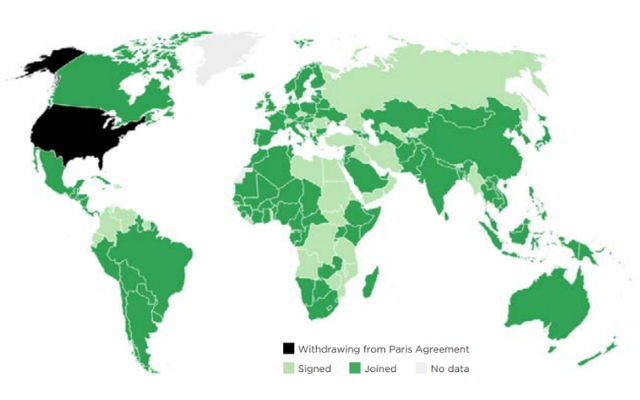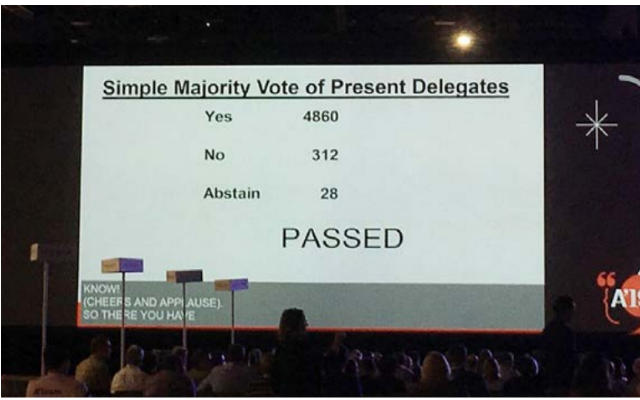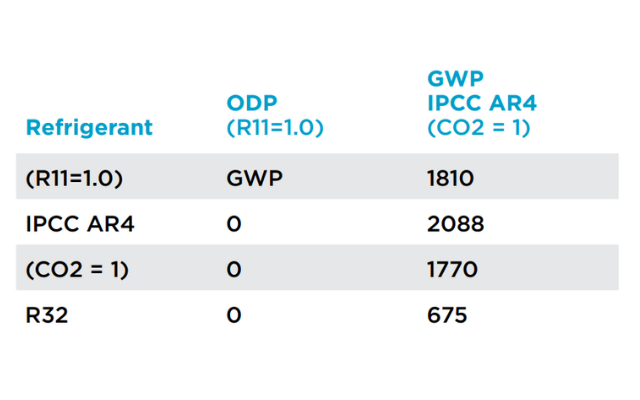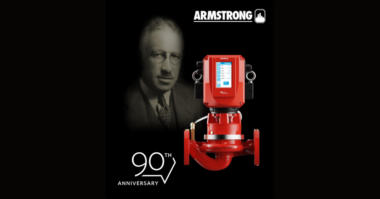Contributor: Luke Leung, PE, P Eng, LEED Fellow, AHR Expo Expert Council Member; Marzia Sedino, PE, LEED AP; Daniel Leung
At the 2020 AHR Expo, Luke Leung will host an industry trend session titled, Pivoting Towards a Post Carbon World and Impacts to the HVAC Industry. This session is slated for Monday, February 3rd from 12:30 PM – 1:30 PM in W310A. In the below article, Luke and industry colleagues discuss the current state of carbon emission.
The World is Raising the Bar on Carbon Emission
On December 12, 2015, a monumental agreement was made to combat climate change. The Paris Agreement brought almost every nation together in an ambitious effort to advance the creation of a low carbon future. This historical event led to the creation of an important mission: to keep the global temperature rise below 1.5 degrees Celsius above pre-industrial levels¹ before 2050. Globally, countries are making efforts to reduce their carbon footprint and create a more sustainable society. Although the United States officially withdrew from the Paris Agreement back in 2017, many American states, cities, and even individual businesses and organizations have pledged their support to continue pursuing the goals of the Paris Agreement.
US Cities and States Are Raising the Bar
Efforts in the United States, such as the “We Are Still In” declaration (which to date is the largest cross-section of the American economy yet assembled in pursuit of climate action), has shown continued American support for the Paris Agreement².
One of the most notable actions for the reduction of American carbon footprint comes from the city of Berkeley, California. In July 2019, it became the first American city to ban the use of natural gas in new low-rise buildings and homes. Menlo Park and San Luis Obispo, California followed Berkeley’s lead in banning natural gas. Los Angeles, Palo Alto, Petaluma, San Francisco, San Jose, Santa Monica, Santa Rosa, Sunnyvale, and 50-60 other cities and towns in California are all considering the same ban. Outside of California, Seattle, WA, and multiple cities in Massachusetts and Minneapolis are also considering similar bans. New Jersey has a draft of a master plan that would end natural gas use in buildings by 2030³. Local Law 97 (of 2019) in NYC limits carbon emissions for most buildings over 25,000 square feet and alternative compliance paths for certain types of buildings. The University of California Office of the President Carbon Neutrality Initiative, the “Clean Energy D.C. Omnibus Act” of 2018, Net Zero Building codes in Massachusetts, local gas moratoriums and others, are driven by the goal of net zero carbon and elimination of fossil fuel.
Professional Organizations Are Raising the Bar
In a historical resolution, American Institute of Architects (AIA) declared a climate emergency and passed the Climate Action. The AIA has adopted the Resolution for Urgent and Sustained Climate Action. The historic resolution passed 4,860 to 312 at the 2019 AIA National Convention in Las Vegas (Fig. 2). It declared, “…NOW, THEREFORE, BE IT RESOLVED, that commencing in 2019 and continuing until zero-net carbon practice is the accepted standard of its members, the AIA prioritize and support urgent climate action as a health, safety, and welfare issue, to exponentially accelerate the “decarbonization” of buildings, the building sector, and the built environment….”⁴
The American Society of Heating, Refrigeration and Air Conditioning Engineers (ASHRAE) position on “Climate Change” was documented in their Position Document dated June 27, 2018. It states that “…The recent Paris Agreement and the adoption of the Kigali Amendment to the Montreal Protocol show that broad international consensus exists on the need for action. ASHRAE’s direct interest in, and concern regarding, GreenHouse Gases (GHGs) and climate change are reflected in its activities in HVAC&R technologies and applications. HVAC&R systems contribute to GHG emissions in terms of direct refrigerant emissions (CFCs, HCFCs, and HFCs) and indirect CO² emissions associated with the energy needed for operating buildings and building systems. As a result, ASHRAE and its members have an important role in mitigating and adapting to climate change…”
Impact on Equipment Manufacturers
Manufacturers must raise the bar and stay ahead of a changing industry before the electrification of the built environment arrives. In order to accommodate for the new changes in design, economy, code, standards and the push for a zero-carbon emission, replacements for products derived from fossil fuels are necessary for this transition period. Manufacturers can decide whether they want to be champions of the change, or be a follower that only switches when they are forced to. There are at least two areas that may be of interest: (1) operating carbon and (2) embodied carbon.
1. Operating Carbon
Electrification of the built environment will require new equipment. Continual improvement of the existing equipment efficiency is a must. Replacing a natural gas hot water boiler (domestic hot water or heating boiler) with a heat pump is an obvious alternative if natural gas is banned. Selected air to water heat pump products have already made it to the Top 10 of the BuildingGreen 2016⁵ using Carbon Dioxide as refrigerant. The coefficient of performance (COP) of similar products can be as much as four times greater than conventional gas hot water heaters. Air to Water Heat Pump heaters with a focus on higher instantaneous capacity (requiring less hot water storage) will be important to push this market. Also new equipment with standard industrial ratings, including ASME, Factory Mutual, or UL listing, are important. While not available in the US yet, Daikin has engineered a variable refrigerant flow (VRF) system that can use the heat waste from generating chilled water to provide domestic hot water. The system can also provide heating for radiant floor applications. These so called “three in one” units are also available from Mammoth in their international market, namely in China and Canada. Electric heat pump equipment, including air to water and air to air heat pumps, needs to be tested and rated to low outside air temperature (0°F and below) in regard to their heating capacities. Air to air heat pumps can be a more efficient replacement to packaged terminal air-conditioning units (PTAC). Air to water heat pumps, in order to be applied in domestic hot water heating, require the ability to deliver 140 °F hot water even when outside temperatures reach -10 °F or lower temperatures. This can be a challenge in cold climates, such as Chicago, without auxiliary electric heating.
Refrigerant is another area that needs to be addressed. While the most harmful refrigerants such as R22 were banned and replaced by better ones, such as R 410 A, several common refrigerants on the market still have high Global Warming Potential (GWP). (Fig. 3)
Cooking is the other obvious use of gas in a building. Induction cooking is getting more popular as an alternative. While the general perception is that induction cooking is more efficient than gas or electric cooking, an Electric Power Research Institute (EPRI) study indicated that it is not always the case. It can vary pending on the size of the cooking vessel when compared to conventional electric cooking⁶. The United Nations World Health Organization suggests that there is no compelling evidence that medium frequency fields of induction cooking have a long-term effect on human’s health⁷, though it also has admitted that more research needs to be done. However, in a study conducted by the Swiss government, it was concluded that depending on cooking zone and cooking vessels used⁸, it is possible that induction cooking can exceed the guidelines defined by the International Commission on Non-Ionising Radiation Protection which indicate a maximum magnetic flux density of 6.25 microtesla (QT) at a distance of 30 cm.
2. Embodied Carbon
In the next twelve months the HVAC industry will see a shift of focus from operational carbon to embodied carbon. Multiple conferences and events, such as Carbon Positive in Chicago, the AIA Large Firm Round Table, and the follow up Carbon Positive in Los Angeles in 2020 will gather the participation of major industry players and will focus on embodied carbon. The AIA Architecture 2030 Challenge has already adopted an embodied carbon roadmap⁹, and the structural engineering community has also defined one of their own¹⁰. Many design firms are starting to use commercial software, similar to Tally, to estimate the embodied carbon footprint of their buildings. A new open-source tool that can be used to track the carbon emissions of raw building materials, called the Embodied Carbon Calculator for Construction, could be a helpful tool in reducing the carbon footprint of construction projects.
The Embodied Carbon Calculator for Construction, or EC3 for short, was developed by the Carbon Leadership Forum in collaboration with Skanska and C-Change Labs. It was additionally piloted by Microsoft. While this is an advancement in the design industry, the impact of HVAC equipment and parts, including ductwork, piping, metal, etc. cannot be properly accounted for due to a lack of embodied carbon data or Environmental Product Declaration (EPD) information for these products.
The construction of a single “low embodied carbon” office building could save 30 million kilograms, or 33,000 tons, in carbon emissions. Kate Simonen, founding director of the Carbon Leadership Forum and associate professor at the University of Washington, says that this is “the emissions equivalent of avoiding driving a car around the Earth 3,000 times.”¹¹
Conclusion
Many entities have proclaimed that we are in a climate emergency: the political leaders, professional organizations, the Net Zero codes, the gas banning regulations, the voices of numerous cities, and recently, the cry of the younger generation demanding change¹². The world needs the entire HVAC industry to be the relevant leader of this change to reduce both operating and embodied carbon. This is a crisis that the HVAC industry must champion the solution for.
Luke Leung, PE, P Eng, LEED Fellow, AHR Expo Expert Council Member
 Luke Leung is the director of the MEP + Sustainable Engineering Studio for SOM. Leung leads his team in attaining the highest levels of human, environmental, and financial performance. He has won multiple awards, including eight “Excellence in Engineering” awards from the American Society of Heating, Refrigeration, and Air Conditioning Engineers (ASHRAE), two “Beyond Green” awards from the National Institute of Building Sciences, and several sustainable design awards from the American Institute of Architects (AIA). Additionally, Luke is a member of the AHR Expo Expert Council, The Council is a collaboration of HVACR experts and thought leaders launched by the AHR Expo in 2019 to educate and stimulate discussion concerning the biggest issues impacting the industry.
Luke Leung is the director of the MEP + Sustainable Engineering Studio for SOM. Leung leads his team in attaining the highest levels of human, environmental, and financial performance. He has won multiple awards, including eight “Excellence in Engineering” awards from the American Society of Heating, Refrigeration, and Air Conditioning Engineers (ASHRAE), two “Beyond Green” awards from the National Institute of Building Sciences, and several sustainable design awards from the American Institute of Architects (AIA). Additionally, Luke is a member of the AHR Expo Expert Council, The Council is a collaboration of HVACR experts and thought leaders launched by the AHR Expo in 2019 to educate and stimulate discussion concerning the biggest issues impacting the industry.
Sources:
- https://unfccc.int/process-and-meetings/the-paris-agreement/what-is-the-paris-agreement
- https://www.wearestillin.com/we-are-still-declaration
- https://www.forbes.com/sites/energyinnovation/2019/07/22/as-cities-begin-banning-natural-gas-states-must-embrace-building-electrification-with-smart-policy/#749ee0d76ce6
- https://network.aia.org/HigherLogic/System/DownloadDocumentFile.ashx?DocumentFileKey=0e6ea336-5683-4c20-b85e-90571ce12108&forceDialog=0
- https://www.treehugger.com/sustainable-product-design/envelope-please-buildinggreens-top-10-green-picks-2016.html
- https://ww2.energy.ca.gov/2016publications/CEC-500-2016-034/CEC-500-2016-034.pdf
- WHO: Extremely Low Frequency Fields. Environmental Health Criteria Monograph No.238, 2007
- https://www.brooklinema.gov/DocumentCenter/View/20420/SWITZERLAND_EMF_report_2011-see-page-3?bidId=
- https://architecture2030.org/2030_challenges/embodied/
- http://carbonleadershipforum.org/signatures/SE2050commitment/
- https://www.washington.edu/news/2018/12/03/carbon-accountability-uw-architecture-professor-kate-simonen-sees-progress-in-work-to-reduce-embodied-carbon-in-construction-materials/
- https://www.google.com/search?source=hp&ei=iq6BXeSJH8PcswXvz57QBQ&q=young+people+voice+demand+climate+emergency&oq=young+people+voice+demand+climate+emergency&gs_l=psy-ab.3…116.10273..10470…6.0..0.148.5433.17j32……0….1..gws-wiz…….0i131j0j0i10j0i22i30.D6a-eRgKuhc&ved=0ahUKEwjk9qPMwNnkAhVD7qwKHe-nB1oQ4dUDCAg&uact=5







Comments